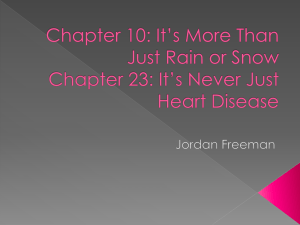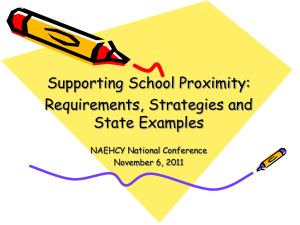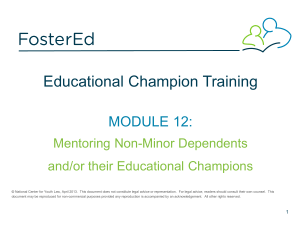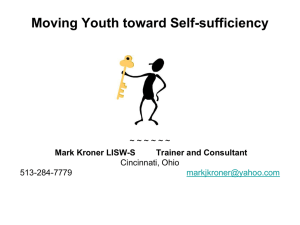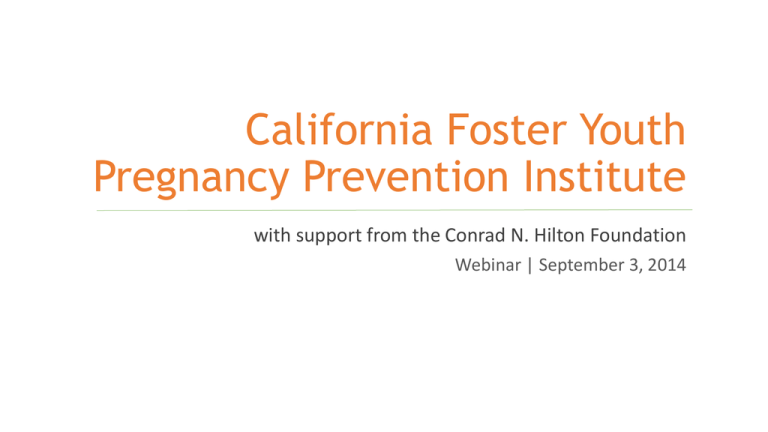
California Foster Youth
Pregnancy Prevention Institute
with support from the Conrad N. Hilton Foundation
Webinar | September 3, 2014
AGENDA
• Introduction of Institute Partners
• Overview of the Issue
• Understanding SB 528
• California Foster Youth Pregnancy Prevention Institute
• Past Successes with the Teen Pregnancy Prevention Integration
• Institute Participant Activities and Institute Timeline
• Application Information
• Questions and Closing
Institute Partners and Presenters:
• Amy Lemley, John Burton Foundation
• Phil Basso, American Public Human Services Association
• Rebecca Griesse, The National Campaign to Prevent Teen and
Unplanned Pregnancy
• Mary Doyle, Representative from the Minnesota TPP Integration Team
• Cecilia Tran, John Burton Foundation
Compared to their non-foster peers:
Foster youth are more likely to:
Begin having sexual intercourse
at an earlier age
Have more sexual partners
Use contraceptives more
inconsistently
Experience intimate partner
violence that includes forced sex
Foster youth are more
likely to:
Experience teen
pregnancy and child
bearing
Contract sexually
transmitted infections
(STI)
Cumulative Percentage of Girls in a Los Angeles County Foster Care
Placement at Age 17 Who Had a First Birth as a Teen, 2003-2007
40.0%
34.3%
35.0%
27.5%
30.0%
25.0%
19.0%
20.0%
15.0%
11.5%
10.0%
5.0%
0.0%
1st birth before 18
1st birth before 19
1st birth before 20
1st birth before 21
21 year old men who impregnated a partner or fathered a child:
60%
50%
Foster Youth
49%
General Population
40%
30%
30%
20%
19%
12%
10%
0%
Impregnated a Partner
Fathered a child
The number of older youth in foster care has
increased considerably
9,000
# of NMDs in extended foster care on April 1st of that year
8,000
7,000
6,000
3,794
5,000
2,692
4,000
3,000
2,000
1,373
1,321
1,630
1,366
3,876
2,669
1,000
1,457
1,429
1,332
1,565
2009
2010
2011
2012
0
Female
Male
2013
2014
Key Findings from a Study of Foster Youth in
LA County:
• By age 5, children born to teen mothers who had been in out-of-home
care were abused and neglected at twice the rate of other children
• 1 in 3 girls in foster care who gave birth before they turned 18 will
have at least one more teen birth
• Even with controls for other health factors, maternal history of being
in neglected or abused was a predictor of infant low birth weight.
SB 528: Pregnant and Parenting Youth in
Foster Care
Key Components:
1. Establishes foster youth’s right to access sexual development and
reproductive health information and services
2. Requires counties to collect data on parenting foster youth and DSS
to make it publicly available
3. Authorizes child welfare agencies to have specialized planning
conferences to update case plans when a foster youth is pregnant
SB 528: Pregnant and Parenting Youth in
Foster Care
• Chaptered in September 2013
• A core component of the bill establishes that foster youth ages 12 and
older have the right to receive health services and age-appropriate,
medically-accurate information relating to:
• The prevention of unplanned pregnancy
• The prevention and treatment of sexually transmitted infections
(STI)
• Authorizes social workers to inform foster youth about these rights
and assist with accessing these health services.
Foster youth are not accessing pregnancy
prevention information:
• Between fiscal year 2007-2008 and 2012-2011, the state cut funding
for teen pregnancy prevention programs by $33.5 million
72% decrease in TPP funding
94% reduction in participants served by TPP
programs
• While some new federal funds have been accessed by the state, the $5
million was to be distributed among 21 agencies in 2012-13.
How can the California Foster
Youth Pregnancy Prevention
Institute make a difference?
The California Foster Youth Pregnancy Prevention Institute
Institute Goal: The Institute will partner with six county teams consisting of 3-5
individuals from each county’s child welfare agency to incorporate pregnancy
prevention strategies into services for foster youth
Agencies will become more effective at providing pregnancy and STI
prevention services for foster youth
Participants will be able to use the tools and methods gained through
the Institute to assess agency issues and drive sustainable changes
Develop a comprehensive county policy to address reproductive health
and pregnancy prevention for foster youth
Institute Approach: The Institute will provide the tools and technical
assistance to help counties develop county policies that are compatible with the
needs of that region, taking into consideration local resources and existing
pregnancy prevention efforts.
Change
Management
Curriculum
Options
County Policy,
Practice, &
Organizational
Supports
APHSA’s
Organizational
Effectiveness
Practice &
DAPIMTM
Strategies offered by the Institute:
Youth-Focus:
Caregiver
Focus
Social Worker
Focus
Pregnant and
Parenting
Teen Focus:
Making Proud
Choices: An
Adaptation for
Youth in Outof-Home Care
Families
Talking
Together
Two
Curriculum
options
Pregnant and
Parenting Teen
Conference
Organizational Effectiveness is a systemic and systematic approach
to continuously improving an organization’s performance,
performance capacity and client outcomes.
Why Use OE? The sustainability and impact of practice
innovations and policy reforms are enabled by well-aligned
organizational capacity, sound organizational functioning, and a
culture of continuous improvement.
Since 2004, APHSA’s OE practice has been developed and used in
over 30 states through more than 75 projects.
APHSA OE has recently been evaluated, with strong connections
found between using OE tools, implementing desired changes,
improving organizational functioning, improving agency partnerships,
and improving the impact on those served.
Why Use OE for this Institute?
To move the actual work forward during and between sessions!
An up-front readiness review: “How fast, how much, and with what
support?”
Up front work on an effective change management structure
Access to curriculum options and how best to embed them in practice
Access to OE tools based on your actual challenges and obstacles
Help in selecting a set of solutions that address the reasons for current gaps
Reinforcement of essential resource management and monitoring activities
Ongoing peer to peer learning, support and exchange
Dedicated team time away from your day jobs
National visibility of the great work you’re doing
Examples of OE Tools:
Sponsor group charters for improvement & implementation teams
The “DAPIM” Flywheel
Communication planning
Continuous improvement planning
Assessing current readiness for change
Topic-specific improvement tools including those for trust, retention, staff
buy-in, and partnerships
Managing meetings and facilitating teams
Using data to monitor progress, impact, lessons, and adjustments to make
Sneak Peek at the “DAPIM” Flywheel and Work Products
Define
Monitor
Work products – baseline
surveys and measures,
alignment notes, initial
feelings, ground rules, defined
areas for improvement
Work products – monitoring
quick wins, and other
changes, evaluations and
measures of progress and
impact
Implement
Work products – team
activities, action plans,
charters for working teams,
communication efforts
Performance &
Capacity
Assess
Work products – findings:
strengths and gaps, root
causes and general remedies
Plan
Work products – quick wins,
mid- and long- term
improvement plans,
communication and capacity
plans
Two Examples of OE Helping Agencies:
• Charlottesville, VA (through an Institute)
• Hampton, VA
Has this approach been
tried before?
Integration of Teen Pregnancy Prevention into State and
Local Child Welfare Systems Project:
• The TPP Integration project adapted an evidence-based curriculum Making
Proud Choices: An Adaptation for Youth in Out-of-Home Care (MPC+).
• Worked with 5 state and local teams with different levels of needs and
resources to implement the MPC+ curriculum:
•
•
•
•
•
Alameda County, California
Hawaii
Minnesota
North Carolina
Rhode Island
Most counties experienced budget
constraints and overcame these
barriers by building curriculum into
existing systems.
Implementation: What did we learn from the
Institute?
Institute framework and written plans were helpful
Dedicated time to work as teams away from normal, busy schedules was
important
Idea exchange, collaboration & networking aspect across states were also
very helpful
Varied representation/diversity across sites
Teams increased cross-collaboration, particularly between
child welfare and public health
TPP Integration Successes
• Trained 333 foster youth participants with the MPC+ curriculum:
88% of participants said they learned more about pregnancy prevention
89% of participants said they learned more about STI prevention
86% of participants said they enjoyed the class
• Developed strong networks with individuals from private and public agencies
from child welfare and public health sectors
• Identified and filled gaps of service in existing systems
• Sustainability plans were set in place to ensure that the work continued after the
TPP Integration project ended
State Successes:
• Hawaii: Implemented MPC+ in 3 out of 4 ILPs statewide.
• Alameda, CA: Presented MPC+ curriculum overview to 1100+ child
welfare staff and caregivers
• Rhode Island: Integrated MPC+ into state-wide Life Skills program
Minnesota’s Experience with TPP Integration:
Reasons for Participation:
• MN Dept of Health and Dept. of Human Services: Birth rate of youth who had
been in care for more than 30 days was 2.5 times the rate of the general
population of girls ages 15 to 19.
• Implications for long term education and employment outcomes.
Method:
• Collaborated with state-funded Independent Living Programs, a correctional
site, and a mental health site for youth to implement the Making Proud
Choices for foster youth.
• Program promotions and additional services provided
• Trained social workers on MPC curriculum and on sexual health and
development basics with help from public health partners.
Minnesota Experience:
Outcomes:
• Increased awareness and coordination between public health and child welfare
systems
• Social workers: Knowledge of the population/trauma-informed care
• Public health workers: Sexual development and sexual health knowledge
• Sustainable training model: Youth workers are spreading the trainings to other
foster youth service providers after they learn it
• Broad and continued interest in utilizing the curriculum and training
Public
Health
TPP
Integration
Child
Welfare
Institute Timeline:
Dec. 8-9, 2014
Feb. 26-27, 2015
April 20-21, 2015*
Oct. 15, 2014
Application
Conference Call
Sept. 23, 2014
Application
Due
Selection
Announcement
Oct. 29, 2014
*All Institute sessions will take place in Los Angeles
Institute
Sessions
Evaluation
Process
May to Oct. 2015
Institute Costs:
Costs Covered by
the Institute:
• Institute sessions
• Lodging
• Food
Costs Covered by
Sponsoring Agencies
• Ground transportation
• Airfare
Participant Activities:
Attend three, 2-full day in-person sessions that will take place in Los Angeles to learn about
pregnancy prevention strategies and organizational effectiveness tools to support their
implementation and impact
Activity
In-Person Sessions
Day 1 and Day 2
December 8-9, 2014
Day 3 and Day 4
February 26-27, 2015
Day 5 and Day 6
April 20-21, 2015
Engage in intersession work in which models, tools, and strategies from Institute sessions
are adapted and applied for use at the county level
Provide baseline data, process data, and ending data to the evaluation team for project
planning and implementation assessment
Assist in developing case studies formulated by the institute team on each participating
county
Intersession Work:
• Forming and briefing a Sponsor Group
• Forming and leading a Continuous
Improvement Group with support
from an Institute staff liaison
• Creating a series of change
management work products
• Implementing change plans and
launching related work teams
The Sponsor Group consists
of senior agency leaders and
others with the authority to
secure resources and provide
direction for pregnancy
prevention efforts.
The CI Group consists of
public and private partners,
staff at different
departments or levels of the
agency, and foster youth or
foster parents who develop
and help implement specific
strategies for reaching
related goals.
Interested in Participating in the Institute?
Applications can be found here
Application Due Date: October 15, 2014 by 5 pm.
Completed applications should be sent to:
Attn: Cecilia Tran
John Burton Foundation
235 Montgomery St. Suite 1142
San Francisco, CA 94104
Please feel free to contact Cecilia Tran at cecilia@johnburtonfoundation.org
with or at (415) 693-1323 with any questions.
Any Questions?
Thank you for your participation!
Sources
American Public Human Services Association (2010). Positioning Public Child Welfare Guidance, Section on Change
Management. To be found at ppcwg.org
Basso, P., Cahalane, H., Rubin, J., & Jones-Kelly, K. (2013). Organizational Effectiveness Strategies for Child Welfare. In H.
Cahalane (ED.), Contemporary Issues in Child Welfare Practice (pp. 257–287). New York; Springer
Midwest Evaluation of the Adult Functioning of Former Foster Youth: At Age 19
Midwest Evaluation of the Adult Functioning of Former Foster Youth: At Age 21
Malvin, J; J. Yarger & C. Brindis (2013). Teen Pregnancy Prevention in California after State Budget Cuts. Bixby Center for
Global Reproductive Health, Philipp R. Lee Institute for Health Policy, University of California, San Francisco.
Manlove, J; K. Welti, M. McCoy-Roth, A Berger & K. Malm. (2011). Teen Parents in Foster Care: Risk Factors and Outcomes for
Teens and their Children. Washington, D.C. Child Trends.
Ng, A. S., & Kaye, K. (2013). Why It Matters: Teen Childbearing and Child Welfare. Washington, DC: The National Campaign to
Prevent Teen and Unplanned Pregnancy.
Putnam-Hornstein, E.; J. Cedarbaum, B. King, & B Needell. (2013). California’s Most Vulnerable Parents: When Maltreated
Children Have Children. Los Angeles, CA. Conrad N. Hilton Foundation.




